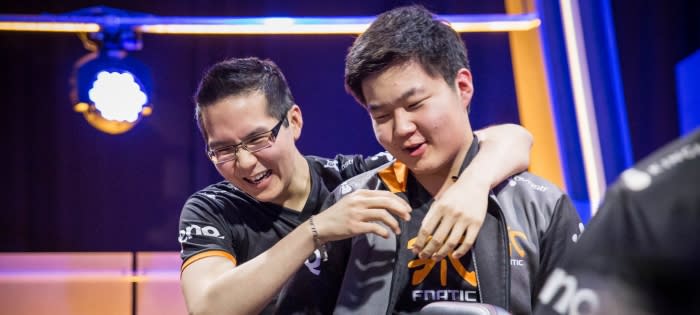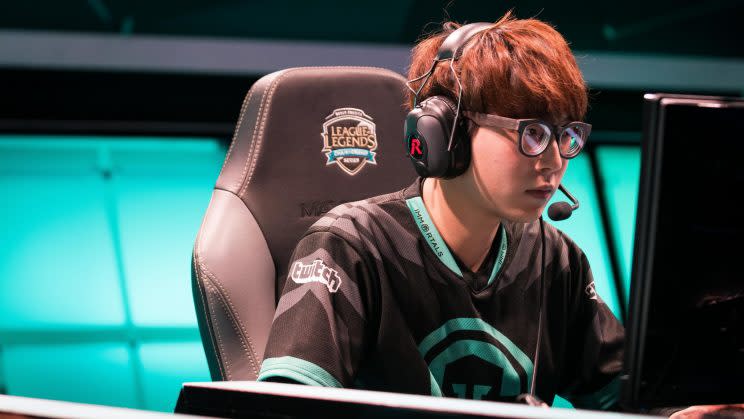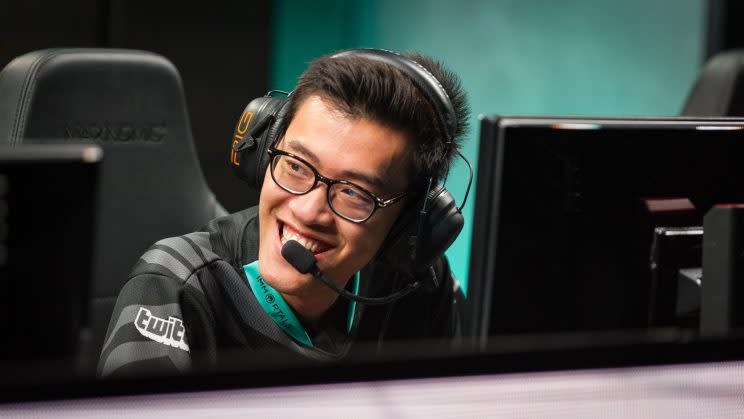Top to bottom: How Huni's LCS bottom lanes may have molded him

Tank top laners do more damage than carries, so it’s only natural Heo “Huni” Seunghoon would play them in the new season. Similar jokes flooded social media when the notorious ex-EU LCS and NA LCS top laner selected a tanky top lane pick two games in a row during his debut for SK Telecom T1. The champion picks jarred a narrow view of Huni that has become ubiquitous. If Huni’s new behavior doesn’t align with the common narrative, it’s hard to gauge whether it will persist or if SKT can continue to find success in showing their audience new dimensions to their top laner.
The relationship between bottom and top lane isn’t discussed except to illustrate the importance of Teleport calls. Cho “Mata” Sehyeong, for instance, often received credit for pulling Samsung White and Royal Never Give Up top laner, Jang “Looper” Hyeongseok, to the bottom side of the map at precise times. While an exaggeration of what actually happened, this famous example of the relationship between a top laner and support gives only a limited view of how important synergy between the two sides of the map can be.
Bottom and top lane sandwich the map in League of Legends. Where a jungler positions on different sides of the map can help develop an aggressive top laner or a tank aficionado, and the bottom lane is left to compensate.
The first two major league teams of Huni’s career, Fnatic and Immortals, featured bottom lanes that facilitated a specific playstyle for Huni. Both had specific ways to play the laning phase, and Huni developed in a way that attempted to overcompensate for their peculiarities. A tour of Huni’s history can help examine whether SKT’s bottom lane can help facilitate a new era for him, starting with his debut season on Fnatic.
In 2015, Fnatic recounted the story that lead them to build their undefeated LCS Summer and World Championship semifinalist roster.
Cocky and inexperienced, a top laner from Samsung’s training squad challenged Fnatic to a scrim in Korea during the 2014 World Championship, decimating the European hopefuls. Later, Bora “YellOwStaR” Kim would recall the event and advocate Fnatic pick up Huni and the jungler he recommended.
“I had a call with YellOwStaR,” ex-Fnatic manager Oliver Steer told Redbull, “and I was like, ‘Do you remember those Samsung training players?’ And he clearly did. Gamsu, Huni. He remembered the games, what champions they played. It clearly had an impact on his memory,” Steer said. “There was a reason he remembered it so clearly.”
Reminiscing over Fnatic’s romantic season might make one forget the setup that made that team function. Kim “Reignover” Yeujin and YellOwStaR divided the map, and some of YellOwStaR’s roams and Reignover’s invades went un-checked. YellOwStaR at times over-peppered the map with wards, but this let Reignover definitively know whether the jungler was on the bottom half. Reignover could use this information to farm or invade, pressuring the top half.
In the bottom half of the map, Fnatic’s slow-building lane had a lot of wiggle room. Martin “Rekkles” Larsson and YellOwStaR often preferred to lane evenly rather than play aggressively to draw attention to themselves or call their own jungler. By contrast, Huni always played as close to his opponent’s tower as his opposition would allow, drawing the enemy jungler to his side of the map and away from Fabien “Febiven” Diepstraten and his duo lane.
Watching Fnatic’s games, it often felt like Huni had only one speed. Regardless of whether he gained an advantage over his opponent or fell behind, he would play as if he had a massive lead to lord over his enemy. He over-extended, dove over-zealously, and his behavior often necessitated Reignover’s protective presence on the top half, making the bottom lane play even more safely.

At the time, I was critical of Huni’s inability to vary his playstyle. While some oversimplified the matter by suggesting Huni couldn’t play tanks, I tried to emphasize his inability to play safely or function without jungle pressure and occasionally throw his leads, regardless of champion. Some of the team’s most memorable losses at the World Championship came in part from Huni’s over-extensions.
Yet that only painted part of the picture. Huni’s and Reignover’s absence from Fnatic in 2016 was significant because it further illustrated the mid and bottom lane’s inability to generate consistent early game pressure. With Febiven falling behind in the mid lane, Rekkles and YellOwStaR continuing to play safely on the bottom side, and Spirit farming without map presence, Fnatic’s lack of early game pressure allowed teams to get leads against them in standard scenarios, debilitating Fnatic when they could no longer lane swap.
At the 2015 World Championship, Coach Luis “Deilor” Sevilla Petit defended his player.
“A lot of people are blaming … Huni, but what Huni does, it’s not only in his hand,” he said. “It’s like he — sometimes he needs backup, or maybe there’s comms regarding something, so he goes somewhere on the map or he makes a play … so it’s like maybe the fans only see him doing X Thing, but there’s a lot behind the thing.”
It’s true that, without access to Fnatic’s comms, it’s hard to know exactly why Huni often played with so little restraint. If he played aggressively from behind or when he knew the jungle was top side and his own couldn’t properly respond, it may have been to give his bottom lane openings to farm easily and get new item spikes.
When this didn’t happen, there was a disconnect between the timing of his aggression and bottom lane’s own plays. In all likelihood, the team advocated that Huni continue playing his way and were not always able to capitalize on it against stronger opponents. I’m still critical of Huni’s over-diving, but a team-wide decision could have constrained his development, restricting the team from creating strategies that relied upon a safe top laner and an aggressive bottom lane carry instead.
Following Fnatic’s defeat at Worlds, Huni’s career took another turn when he ventured to the North American League of Legends Championship Series to join Immortals. Rumors of Fnatic roster moves caused Huni skeptics to roll their eyes even harder. An AD carry rework misled pundits to forecast 2016 as a return to the era of bottom lane domination. Huni initially wanted to swap to AD carry so he could have the largest impact.
Immortals CEO Noah Winston described a conversation between Huni and Reignover.
“Huni saw that the patch was going to be AD-centric,” he said. “He knew the next meta was going to be one in which the AD carry had more carry power than the top laner. Being the carry style player that he is, Huni said ‘I want to play ADC.’ Reignover said, ‘Huni, you play too aggressively, your playstyle is exactly the wrong type for ADC. You’re going to stay top lane.’ And Huni said, ‘Okay, I’m going to stay top lane.’”
This exchange reinforced the rough image of Huni that lingered following Fnatic’s World Championship run. Brash and unapologetic with a selfish need to carry and get in the face of his foes, Huni seemed like the opposite of a malleable team player.
Immortals’ disappointing playoffs collapses cranked this up to eleven. After a 17-1 run in Spring NA LCS, Immortals lost 0-3 to Team SoloMid in semifinals. The most iconic moment of the series was when Huni selected Lucian for the top lane. He finally got his wish to play AD carry, but it had embarrassing consequences, as he ended the game with a 2/4/4 scoreline. Later, IMT’s cringeworthy summer playoff semifinal against Cloud9 featured a haphazardly over-extending Riven. As the stakes increased, one could only conclude that Huni’s pressure to solo carry rose at the expense of team play.
“Because we practice so well, there are situations where we can almost play whatever we want,” Coach Dylan Falco said following Immortals’ first loss to Team SoloMid. “It becomes really hard to find weaknesses in our strategy because of our practice, until we play a strong team like TSM.”
Falco’s willingness to let Huni play presumably what he wanted and assuming the team was good enough to get away with it painted him as a coach who wasn’t strict enough to develop the mercurial player. But the more interesting question wasn’t why Falco decided it was a good idea to “pick whatever we want,” but why Huni found it desirable to play the likes of Lucian top and Riven in high-pressure situations.
The easy answer is that he was simply oblivious of the meta and the disadvantages of his picks, but it’s hard to believe Huni would so adamantly ignore the signs around him. Did it never occur to him that these choices weren’t the best idea if no one else played them? Did his first dive on Riven not caution him against repeating the error with a larger deficit?
Once again, it seems more likely that the answer rests in Huni’s relationship — not with his coach, but with the players on the opposite side of the map. Jason “WildTurtle” Tran and Adrian “Adrian” Ma are not Rekkles and YellOwStaR. No one would say WildTurtle plays too far back in lane and doesn’t try to trade with his opponents, and his increased aggression is reflected in 21.2 percent of his team’s deaths during Immortals’ 17-1 2016 Spring season compared to Rekkles’ 13.6 percent of team deaths in Fnatic’s 18-0 2015 Summer season.
Upon first joining the LCS for Team SoloMid in 2013, his lane partner Xpecial characterized the difference between WildTurtle and his predecessor, Shan “Chaox” Huang.
“When I play support with [Chaox], it’s like a well I’m pretty much always going to be in front of him sort of thing, and now when I play with Turtle, I try to get in front of him, but he’s always pretty much in the front … It means I have to try to peel people off WildTurtle.”
WildTurlte has never truly lost that instinct, even as NA bot lanes have improved in their ability to punish his behavior.
Rather than being relied upon to generate lane pressure and draw the enemy jungler away as he did with Fnatic, Huni had to take advantage of WildTurtle’s forward positioning by amassing his own lead and ensuring he could carry. Though WildTurtle would demand attention (perhaps contributing to Adrian’s affinity for peel-oriented champions), he would rarely put himself in a position where he could convert that early pressure into a victory.
As a result, Immortals actually benefited a lot from lane swaps, accumulating greater experience and gold leads in the early game when they swapped. They could use WildTurtle’s ability to push quickly and leave Huni with time to farm a wave.
Despite a reputation for aggression and constant fights, Immortals excelled in lane swaps. Huni had an ability to carry easy with a long lane to farm, and WildTurtle wasn’t punished as heartily for his over-extensions.
In standard lanes, it felt like Reignover was split. Occasionally, mid laner Pobelter would contribute to the high pressure requirement Immortals created by roaming bottom when Reignover roamed top. In reality, however, jungle and mid couldn’t compensate for both lanes, especially since neither of them seemed willing to dial down their aggression if the enemy jungler appeared on their side of the map.
Huni, with the urge to get a massive lead in lane and carry, defaulted to picks he felt most comfortable on, like Riven. WildTurtle continued attempting to go off, and both lanes created easy targets for Cloud9.
On both Fnatic and Immortals, team dynamic relied on Huni playing a constantly high pressure style that made it look like he didn’t understand how to play from behind, in part because the bottom lanes didn’t adapt either. The symbiotic relationship stagnated and kept both sides of the map from changing. These problems likely could have been identified and dealt with by a stronger coaching staff, but either through mutual mistrust or habit, pigeonholed Huni’s style considerably.
With a long history of aiming to go even in lane and an inability to adapt in Huni’s absence, Rekkles probably could not have adapted to give Fnatic an alternative strategy. As WildTurtle has almost always been WildTurtle, it seems likely Immortals’ bot lane could not have easily changed their approach either.

The question now is whether Huni can adapt on SK Telecom T1 and whether or not the team’s bottom lane will create the opportunity for him to do so.
Bae “Bang” Junsik and Lee “Wolf” Jaewan are touted as one of the greatest bottom lanes in the world. Bang often contributes a high percentage to his team’s damage and has stood out despite sharing a roster with the legendary Lee “Faker” Sanghyeok. But of all of Bang’s and Wolf’s accolades, a strong laning phase isn’t one of them.
The weakness of Bang and Wolf’s laning phase was apparent in their debut. Even with strong matchups, Bang and Wolf made many poor trade decisions and fell behind in lane early. Historically speaking, despite Bang and Wolf’s high damage output, and even when jungler Kang “Blank” Sungu played more to the bottom side of the map in 2016 Spring, the touted Korean duo have struggled to truly dominate their opponents early, frequently breaking even at best.
In 2015, SKT relied upon top lane to generate a certain amount of pressure, but Duke did so self-sufficiently. SKT’s current team could easily become another scenario in which Huni feels pressured to play champions that punish their opponents in lane and aggressively dive to pull the enemy jungler top.
But he played Maokai and Poppy in his debut for SKT against Jin Air Greenwings. What’s more, SKT chose Maokai before the enemy top lane pick, and counterpick Kled entered the lane. Huni didn’t continuously try to trade.
Instead of being about bot or top lane pressure, SKT in 2016 relied heavily upon mid lane pressure, with Faker pushing out the lane and Bengi or Blank invading to deny the Raptor’s oracle buff from the opponent jungler. The team didn’t average the highest gold lead at 15 minutes in any of their competitions last year, instead preferring to give up side lane advantages as long as they could take the first Tier 1 mid lane turret. That didn’t mean that Bengi or Blank ganked mid. Rather, it meant that the jungler tried to keep tabs on his opposite to allow Faker freedom to push to the enemy turret.
Based on SKT’s first series in the new season against Jin Air, Han “Peanut” Wangho hasn’t quite mastered this technique. Instead, Peanut ganked mid lane multiple times, and Faker made himself a massive target. When top and bottom lane got advantages, they pushed out their lanes and roamed mid in tandem to acquire kills on Faker.
SKT remained focused, however. They felled the mid lane Tier 1 turret and opened the map for Faker’s roams. His ability to use his lead to exert pressure on both sides of the map pulled the game back.
But SKT still look shaky. Falling behind in side lanes early is troublesome if both opponent side lanes succeed in shutting down Faker. But this style means that there’s another lane on the map that Huni can rely upon to generate early pressure, and suddenly he seems capable of playing a losing lane matchup without fuss.
Following laning phase, then, Bang continues to do what he does best in positioning in fights. Huni’s relationship becomes more about peeling for a bottom lane carry than diving in and hoping his ADC will clean up.
The dynamic between Huni and SKT’s bottom lane is precarious. On one hand, Bang and Wolf’s weak laning phase might create the same scenario that forces Huni to feel like he needs to play aggressively and pull pressure, but alternatively, Bang’s late game strengths mean Huni doesn’t have to carry. With Faker stubbornly pushing out his own lane, neither side of the map may have to worry as much about early game leads.
As competition froths in 2017 LCK Spring, Huni’s relationship with his new bottom lane will continue to develop. No matter which way the scale tips, the result will give us a new glimpse of the globetrotting top laner. It’s up to SKT to fully bring it out.
You can follow Kelsey Moser on Twitter @karonmoser.

